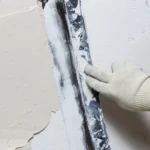Anchoring is the process of securing various structures to a solid foundation – foundation, walls, or load-bearing supports.
An anchor is a fastener for fixing various structures, parts, and mechanisms to a load-bearing base. Depending on the physics of the process, there are two fundamentally different types of anchors – mechanical and chemical.
Mechanical anchor
Traditional mechanical anchor connections work due to the frictional forces that arise between the body of the anchor and the inner surface of the mounting hole in the base after metal collets or a plastic dowel stand against each other. A separate subtype of anchors works by focusing on the inside of hollow materials or drywall.
Such fastenings are extremely strong – the pullout force of metal anchors fixed in concrete can reach 10-15 kN or 1000-1500 kgf.
Despite several obvious advantages – quick installation, absence of weather, and temperature restrictions during operation, mechanical anchoring has several significant limitations. It creates high stress within the material and is therefore not suitable for use in weak and porous substrates – wood, gas, and foam concrete, as well as in the edge zones of strong concrete structures.
Chemical anchor
Unlike a mechanical anchor, a chemical anchor works due to the forces of adhesion and friction that occur at points of contact with micro-irregularities in the hole. And also due to its shape when used in materials with voids, for example, expanded clay concrete or slotted bricks. In some cases, when it is necessary to secure a structure to cellular concrete, a chemical anchor is the only available solution.
A chemical anchor for concrete, brick, wood, or metal is a liquid two-component composition that is squeezed into a hole in the base and hardens when exposed to air.
| Manufacturers of building mixtures produce two main types of chemical anchors – polyester-based, and epoxy-based, for example. |
The maximum pullout load in concrete with chemical anchoring reaches 70-75 kN or 7000-7500 kgf. Which is several times greater than the capabilities of mechanical anchors.
Since there are no additional stresses inside the base, such anchors make it possible to effectively secure structures in wooden and porous materials, natural stone, and aerated silicate bricks. And importantly, chemical anchors work great on the edges of the base and in thin parts – beams, railings, overhangs, or cornices. Therefore, this type of fastening is becoming increasingly popular among construction companies.
ADVANTAGES OF A CHEMICAL ANCHOR OVER A TRADITIONAL ONE
- Withstands heavy loads due to increased anchorage depth and anchor diameter.
- Does not create additional stress in concrete and allows structures to be secured close to the edges of the base.
- Suitable for use on low-strength materials.
- Suitable for fastening to hollow brickwork.
- Protection of fasteners and bases from corrosion and exposure to aggressive chemicals by sealing the connection.
- Fastening reinforcement outlets for subsequent embedding or pouring of reinforced concrete structures.
HOW TO USE A CHEMICAL ANCHOR
Preparing the base
Holes of the required diameter and depth are drilled in the base material. After drilling, it is necessary to clean the hole three times using compressed air and a round wire brush.
Important! Oil compressors must not be used for purging. Oil particles contained in the air stream, if they get on the inner surface of the hole, will impair the adhesion of the anchoring composition.
Since the lifetime of the working composition of a chemical anchor has a limited period – from 4 to 30 minutes depending on the ambient temperature, it is recommended to plan the fastening system and prepare all the holes in the base at the same time.
Application of anchoring compound
Chemical anchors are available in the form of capsules and cartridges or bulk format in buckets for anchoring holes of increased diameter.
| Before installing a chemical anchor for hollow bricks, a special mesh sleeve is inserted into the hole, which prevents the mixture from spreading inside the base and increases the consumption of the composition. |
Cartridge and bulk-type compositions have no restrictions and are suitable for holes of any diameter and depth.
The components of a cartridge-type chemical anchor are located in two independent containers and are mixed when extruded inside a special spiral-shaped mixing spout. The mixing spout is inserted to the full depth of the hole, and using a dispensing gun, the composition is pumped from the inside to the outside so that air bubbles do not form. Then the embedded part is inserted or screwed into the filled hole.
When using self-leveling chemical anchors, the components are mixed in advance in a separate container.
Full Strength Set
Epoxy anchoring compounds harden within 7-70 hours. Fast-curing polyester compounds cure noticeably faster, from 35 minutes to 24 hours.
The chemical curing time anchor depends on the ambient temperature; the higher it is, the faster the composition gains strength.
After complete curing, you can begin installation of building structures.



